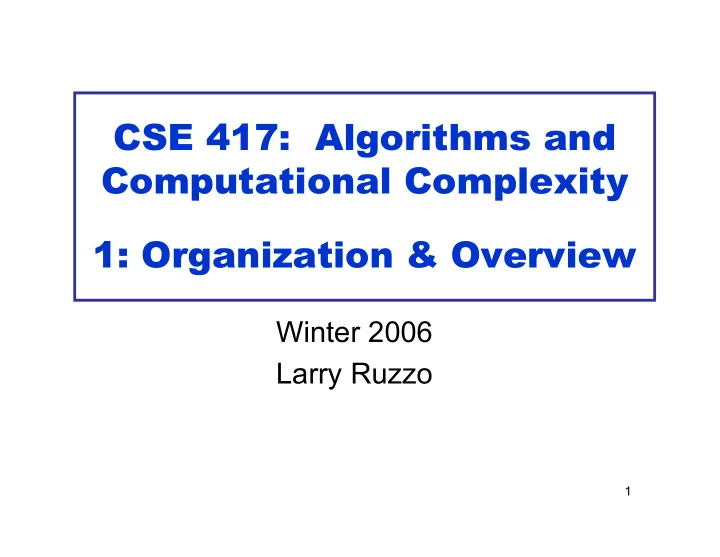

CSE 417: Algorithms and Computational Complexity 1: Organization & Overview Winter 2006 Larry Ruzzo 1
http://www.cs.washington.edu/417 2
What you’ll have to do • Homework (~55% of grade) – Programming • Several small projects – Written homework assignments • English exposition and pseudo-code • Analysis and argument as well as design • Midterm / Final Exam (~15% / 30%) • Late Policy: Papers and/or electronic turnins are due at the start of class on the due date. 10% off for one day late (Monday, for Friday due dates); 20% per day thereafter. 3
Textbook • Algorithm Design by Jon Kleinberg and Eva Tardos. Addison Wesley, 2006. 4
What the course is about • Design of Algorithms – design methods – common or important types of problems – how to analyze algorithms – correctness proofs 5
What the course is about • Complexity and NP-completeness – solving problems in principle is not enough • algorithms must be efficient – NP • class of useful problems whose solutions can be easily checked but not necessarily found efficiently – NP-completeness • understanding when problems are hard to solve 6
Very Rough Division of Time • Algorithms (7 weeks) – Analysis of Algorithms – Basic Algorithmic Design Techniques – Graph Algorithms • Complexity & NP-completeness (3 weeks) • Check online schedule page for (evolving) details 7
Complexity Example • Cryptography (e.g. RSA, SSL in browsers) – Secret: p,q prime, say 512 bits each – Public: n which equals pxq, 1024 bits • In principle – there is an algorithm that given n will find p and q by trying all 2 512 possible p’s. • In practice – security of RSA depends on the fact that no efficient algorithm is known for this 8
Algorithms versus Machines • We all know about Moore’s Law and the exponential improvements in hardware but... • Ex: sparse linear equations over past few decades • 10 orders of magnitude improvement in speed – 4 orders of magnitude improvement in hardware – 6 orders of magnitude improvement in algorithms 9
Algorithms or Hard- ware? Solving sparse linear systems Source: Sandia, via M. Schultz 10
Algorithms or Hard- ware? Solving sparse linear systems Source: Sandia, via M. Schultz 11
Algo- rithms or Hard- ware? The N-Body Problem Source: T.Quinn 12
Algorithm: definition • Procedure to accomplish a task or solve a well-specified problem – Well-specified: know what all possible inputs look like and what output looks like given them – “accomplish” via simple, well-defined steps – Ex: sorting names (via comparison) – Ex: checking for primality (via +, -, *, /, ≤ ) 13
Algorithms: a sample problem • Printed circuit-board company has a robot arm that solders components to the board • Time to do it depends on – total distance the arm must move from initial rest position around the board and back to the initial positions • For each board design, must figure out good order to do the soldering 14
Printed Circuit Board 15
Printed Circuit Board 16
A well-defined Problem • Input: Given a set S of n points in the plane • Output: The shortest cycle tour that visits each point in the set S . • Better known as “TSP” • How might you solve it? 17
heuristic: A rule of thumb, Nearest simplification, or educated guess that Neighbor reduces or limits the search for solutions Heuristic in domains that are difficult and poorly understood. • Start at some point p 0 Usually not guaranteed to give the best or fastest • Walk first to its solution. nearest neighbor p 1 • Repeatedly walk to the nearest unvisited neighbor until all points have been visited • Then walk back to p 0 18
Nearest Neighbor Heuristic p 1 p 0 p 6 19
An input where it works badly 16 4 1 .9 2 8 20 p 0
Revised idea - Closest pairs first • Repeatedly pick the closest pair of points to join so that the result can still be part of a single loop in the end – can pick endpoints of line segments already created • How does this work on our bad example? 21
Another bad example 1 1.5 1.5 22
Another bad example 1 6+ √ 10 = 9.16 1.5 1.5 vs 8 23
Something that works • For each of the n! = n(n-1)(n-2)…1 orderings of the points, check the length of the cycle you get • Keep the best one 24
Two Notes • The two incorrect algorithms were greedy – Often very natural & tempting ideas – they make choices that look great “locally” (and never reconsidered them) – often does not work - you get boxed in • when it works, the algorithms are typically efficient • Our correct algorithm avoids this, but is incredibly slow – 20! is so large that counting to one billion in a second it would still take 2.4 billion seconds • (around 70 years!) 25
Something that “works” (differently) 1. Find Min Spanning Tree 26
Something that “works” (differently) 2. Walk around it 27
Something that “works” (differently) 3. Take shortcuts (instead of revisiting) 28
Something that “works” (differently): Guaranteed Approximation • Does it seem wacky? • Maybe, but it’s always within a factor of 2 of the best tour! – deleting one edge from best tour gives a spanning tree, so Min spanning tree < best tour – best tour ≤ wacky tour ≤ 2 * MST < 2 * best 29
The Morals of the Story • Simple problems can be hard – Factoring, TSP • Simple ideas don’t always work – Nearest neighbor, closest pair heuristics • Simple algorithms can be very slow – Brute-force factoring, TSP • Changing your objective can be good – Guaranteed approximation for TSP 30
Recommend
More recommend